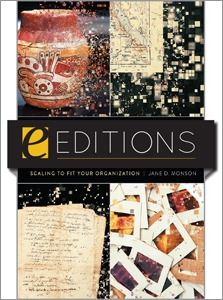
Getting Started with Digital Collections: Scaling to Fit Your Organization—eEditions e-book
The download link for this product can be found on the final confirmation screen after you complete your purchase, and may also be accessed from your Account Profile. For more information about ALA eEditions file types and how to view them on eReaders, desktop computers, and other devices, see this page.
Primary tabs
You don't need to be an ALA Member to purchase from the ALA Store, but you'll be asked to create an online account/profile during checkout to proceed. This Web Account is for both Members and non-Members. Note that your ALA Member discount will be applied at the final step of the checkout process.
If you are Tax-Exempt, please verify that your account is currently set up as exempt before placing your order, as our new fulfillment center will need current documentation. Learn how to verify here.
- Description
- Table of Contents
- About the author
- Reviews
Digital collections have already changed the ways users access and interact with an institution’s materials. And small or medium-sized libraries, archives, museums, and historical societies face a unique set of challenges in regards to digital collections. They may have been unable to jump on the digitization bandwagon at its beginning due to competing priorities or lack of resources, and may now be struggling to get a digitization program in place to meet the evolving needs and expectations of their own users. The good news is that digital projects can scale down to fit the size of any organization. Providing an entry point for librarians, archivists, and curators who are new to digitization, Monson’s well-researched guide shows how even smaller institutions can successfully endeavor to make their content digitally accessible. Clearing aside the jargon and acronyms to hone in on the practicals, this book will help readers get a digitization program off the ground, offering guidance on
- how to efficiently harness existing workflows, especially in departments seeing a decline in workload;
- the pros and cons of the two common service models for state and regional digital repositories;
- how to evaluate and choose among the digital asset management systems, comparing four proprietary and six open source systems;
- hardware options for image capture;
- choices in metadata models MODS, VRA Core, Dublin Core Element Set, and EAD;
- understanding the characteristics of various file formats and using them effectively to create master and derivative files;
- bitstream copying, data redundancy and other strategies to safeguard digital files against media degradation and technological obsolescence; and
- Section 108 copyright exemptions for cultural heritage institutions.
This easy-to-follow guide to digitization fundamentals will ensure that readers gain a solid grasp of the knowledge and resources available for getting started on their own digital collection projects.
Preface
Part I Managing Projects
- Chapter 1 Digitization at Smaller Institutions
- Chapter 2 The Solo Digital Librarian
- Chapter 3 Working across Departments
- Chapter 4 Working across Institutions
Part II Basic Skills
- Chapter 5 Image Conversion
- Chapter 6 Metadata
- Chapter 7 Digital Collection Management Systems
- Chapter 8 Copyright and Digital Collections
- Chapter 9 Preserving Your Digital Assets
Glossary
Index
Jane D. Monson
As the Digital Collections Librarian at the Oregon Historical Society, Jane D. Monson focuses on the development, description, and promotion of the organization’s digital collections. She previously spent 15 years as an academic librarian, coordinating digital library efforts at institutions in Missouri and Colorado. Jane received her MLS from the University of Iowa.
"One of the themes of the book is to find solutions that fit your institution. Monson suggests that we refrain from copying the workflow of a large university or cultural heritage institution because each institution has different limitations and assets that it can use in any project ... One of the best features of this book is the list of suggestions on where to look for additional learning and resources. I would recommend if you are new to the field or are transitioning into digital collections."
— ARBA
"A convenient and practical guide ... Monson's inclusion of management concerns results in a more comprehensive overview of digitization issues for libraries and museums."
— Library Journal


